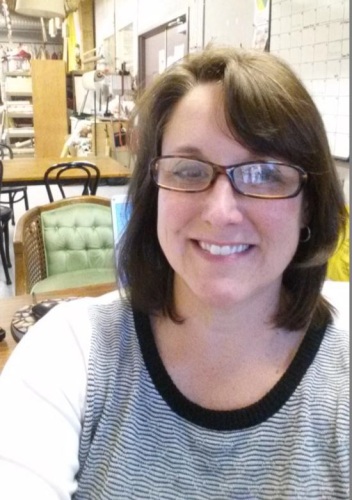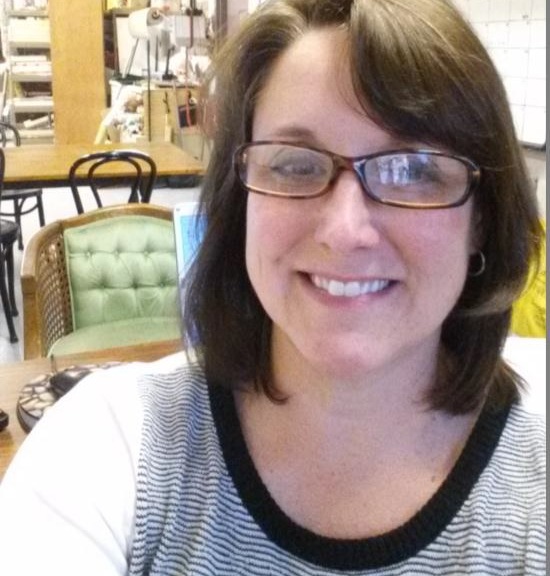The following is one of several interviews conducted by students of Ron DeMarco’s properties class at Emerson College.
Interview with Monique Walker: Prop Master of Village Theatre
by Coco Nakase

Monique Walker, the current props master for the Village Theatre in Washington, answered the phone one February afternoon with encouraging enthusiasm, eager to speak about her rich history of work and the art of props. Monique began in theatre as a high school student, primarily acting in plays and working on the sets in her small town Iowan high school. She had always had an interest in drawing and painting, so when she went to college at University of Northern Iowa, she first majored in Interior Design. “It was in the Home Ec department. And I was like, really? This is awful! It was just decoration, it had nothing to do with architecture or anything like that.â€
So when her high school drama teacher, whose husband was getting a master’s degree at her university at the same time, suggested that she help out with strikes for the drama department, Monique agreed. The Technical Director there then offered her an assistantship, which paid a little and Monique changed her major to theatre, drawn by the collaborative nature of the work. In her sophomore year of college, Monique was props master and the assistant to the guest scenic designer, Jim Bakkom, the original props master for the Guthrie Theatre, for the opera La Boheme. It was under his guidance that she felt like she had started on the right path. Upon graduation, Monique saw that many of her peers were going to graduate school, and she also felt she “needed to grow up a little bitâ€, so she applied and attended Southern Methodist University. “SMU had the best money and you didn’t have to write a thesis. So I was all about that component.†Starting in 1985, she worked every summer at Utah Shakespeare Festival. And although she disliked the “hot glue gun†aspect of the work she did in grad school, she was glad to have finished her MFA in set design. Because of her level of education, Monique was more desirable and trusted by designers. “By the second time I had worked with a designer, it was, ‘well, whatever you pick out’. I got used to doing that, making a lot of choices.â€
When asked if she had had any aspirations as a set designer, Monique admitted she had at the beginning. “It was kinda what they told me to do, but the thing I hated about set design was everyone’s freaking opinion!†She knew she had to go into props when one of her professors, Broadway designer Bill Eckert, had her do this exercise. He told them to draw what they saw from words like frog and flower. For the frog, Monique drew his eyes and mouth and for the flower, she drew every petal. One of her classmates took a very different approach, drawing the motion of the jumping frog and a field of flowers. “And I realized, that it’s detail. It was like a lightning bolt! I don’t care about where the stairs go or the shape of the deck, but I do care about the upholstery on the couch.â€
While she does not label herself an artisan, if she was forced to pick, Monique would consider herself a soft goods artisan. She does not have formal specialized training, but found fabric easy to work with and she taught herself upholstery by taking things apart.
She was hired by Rose Brand, a fabrics company that catered to entertainment industries, while working at Papermill Playhouse as the non-union props manager. She was able to work with a lot of different projects because of her theater training and connections, but Monique ultimately left for a union job at Papermill because “it was really just a business […] I couldn’t see the end of it, and that was the problem. I started to realize about myself is that I need an opening night. […] My manager told me, ‘well, sometimes theatre people can’t be civilians.â€
In the middle of the interview, Monique casually mentioned that she was one of the five founding members of SPAM. At the time, she was working at the Cincinnati Playhouse and was friends with Mary Kay Stone, a fellow props master. The pair knew a handful of other props people working in theatres within driving distance and would get together occasionally, collaborate and lend each other props. Mary Kay enthusiastically suggested that they make these informal connections into a real organization and Monique and the other members, as she put it, took the idea and “sort of ran with itâ€.
Her most recent and current position is as Props Master for Village Theatre in Issaquah, Washington. Having worked on both coasts, Monique has noticed a difference between east and west coast theatre. “One the east coast, you do what you do and you do that. And you get good at what you do, what you call yourself. Here in Seattle, people cross over, there are people who do scenery, and they’ll do props artisan and theatre and that’s ok, everyone accepts it and does it.â€
Working on the east coast for 15 years, Monique finds it hard to get used to, finding the Seattle environment a little too laid back for her perfectionist tastes. Village Theatre has two spaces, about forty five minutes apart, and once a production is finished in one space, it will be shipped off to the other. So when propping a show, Monique has to keep travel and length of run in mind. Shows run almost double the normal amount because of the two spaces, which is a long time for props to hold up. Village Theatre does primarily musicals where “people dance on all the furniture and there can’t be any glass on stage, so it’s difficult to make props that will last that kind of use for that amount of time. With the same budget, I might addâ€. In addition to the list of complications, the Village Theatre puts up in its season one new musical a year, bringing about its own set of challenges. Except for the main pieces of furniture, the propping process doesn’t really begin until rehearsals start. While the new work has been workshopped in years previous, changes in the script can still happen, so although she has a list of props for the show, nothing is solidified until the curtain opens.
Despite the challenges, Monique finds the most rewarding part of her job is having her shop and her staff. Both of the girls working for her are new to props proper this year, but she finds that they have great attitudes toward the work, they figure it out. “Thatâ€, Monique says, “is the key component and the most rewarding part, when you figure it outâ€. Monique has been in the business for years, and as such, knows the classic props tips and tricks, but her employees are fresh, and bring skills like Photoshop and AutoCAD, as well as their unique perspectives to the mix. “It’s when you put all the heads together, and out of the shop comes a bunch of great props!†She emphasized that it’s not just the product that’s important, but the process. “Without a nice shop, without people you like, […] it’s really, what’s the point? It’s low pay, bad hours. Don’t do it without that!â€
Looking back at her past productions, Monique found that personnel really affected the difficulty of a given show. Her third production at Village was Big River, not all that difficult on its own, but a sharp learning curve with the director and a scenic designer who doubled as assistant technical director who had no real training in theater made the experience much harder than necessary. Her second show with Papermill also proved challenging, a production of Gigi, featuring a young Anne Hathaway. “It was a big ass show, and I was critically losing cooperation with some of the union stagehands […] and I had an uncooperative, unhappy resident, I might add, set designer. I would come in with a list, and I had to handle him. But if he didn’t want to talk, he would turn away, pick up the phone and make a call. It goes back to personnelâ€. She went on to conclude that the toughest thing for a prop shop is when everyone is not of the same page, and aren’t running on full cylinders. When designers and directors are in conflict, or when directors are unhelpful, Monique finds that being firm about the logistics is best, and to also provide alternate solutions.
In confidence, Monique stated that as she got higher up the ladder in props, the less she had to do with them physically. As props master, she oversees the whole operation, “artistic shopsâ€, plans and budgets, but does not assign projects to herself, and as such, it is hard for her to point out a specific cool prop from the span of her career. She finds herself proud of the overall big picture and the whole look of the show.
For students interested in working in props, Monique highly suggested to work summers at good stock theatres. “I never took a single props class in all my years of school,†she relates. “I learned everything about real props while I was workingâ€. She continued to say that students should really take props classes if they can, especially if the professor is a SPAM member, and suggested about resumes not to list their productions, but where they worked, who they worked with and their skills, with pictures to round it out.
When asked why people should do props, without a beat, Monique responded, “because I’ve never been unemployed. […] it’s still, twenty five years later, an underappreciated category of theatre production, and that’s because people think it’s dishes and furniture, and, gee, everybody has dishes and furniture. But it’s the finishing touches. It gives things period, it gives things style and if an actor mimes breaking a bottle over somebody’s head, no one is going to believe it. We have TV and films now. Without props, there’s no detail to theatre. Then it’s just dance, and what’s the point in that?â€





